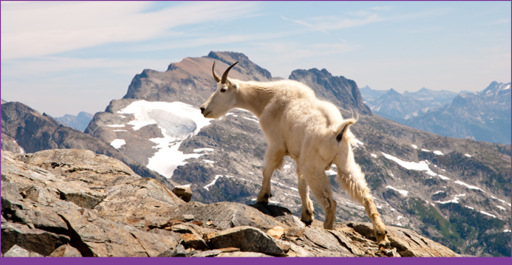
Mountain goats are at home on top the rocky mountains of the North Cascades © Dan Bennett
The North Cascades are brimming with old-growth forests, hundreds of glaciers, and pure alpine lakes. They are a hiker’s paradise as unique in landscape as in name: North Cascades National Park Service Complex. The only of its kind, this complex unites three park units: North Cascades National Park (North and South Units), Ross Lake National Recreation Area (NRA), and Lake Chelan NRA. The mountains, named for an abundance of waterfalls, form an imposing natural barrier, preventing all but the most determined visitors from entering their depths. Many people have tried their luck at making a living among these mountains, but few succeeded. Today, that task is much easier thanks to considerable infrastructure and a healthy, but not overwhelming, tourism industry. North Cascades Scenic Highway pierces the Cascades, crossing them from east to west as the roadway runs the entire length of Ross Lake NRA. Travel further from the beaten path—into river-carved valleys, on top of rocky ridgelines, far away from the scenic byway—and you’ll begin to see the landscape as its earliest inhabitants saw it, wild and free.
Native Americans lived in the mountainous environment for thousands of years. Their lives were tied to the surroundings. Two major tribes lived in the region, one on each side of the Cascades. People of the Columbia River Basin lived to the east. People of the Pacific Northwest/Puget Lowlands lived to the west. They traded between each other, blazing trails across Stehekin (meaning “the way through”), Cascade, and Twisp Passes. They often followed high ridgelines to avoid navigating dense vegetation common in the lower elevations. Natives lived in harmony with the land; many Americans did their best to exploit it.
Several American expeditions traversed the North Cascades, mapping and documenting what they witnessed. Fur trappers came and went. Hundreds of miners hoping to strike it rich arrived in the late 1870s. They panned for gold along the banks of the Skagit River, but found very little. The rush ended by 1880. Trees were felled and floated along the Skagit River and Lake Chelan, but inadequate transportation and infrastructure spared the forests. The most significant alterations to the landscape came in the form of three dams along the Skagit River, but for the most part this rugged land remains wild and free.